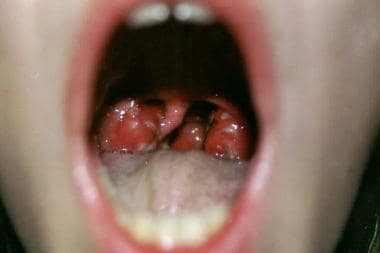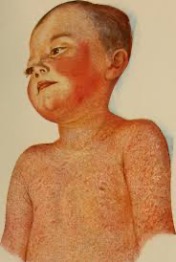The Contagion Column: Scarlet Fever
- Mrs. Cogito
- Oct 25, 2021
- 5 min read

To kick off a new series on Cogito Ergo Cogito where I break down the way infectious diseases spread, affect the body, present as symptoms, and are treated, I will be doing a deep-dive into Scarlet Fever. This series is intended to give you an understanding of different interesting diseases in a way that is simple to digest!
Imagine, for a moment, that you are a parent in the mid-19th century. You've watched as your neighbors' children one-by-one started to complain of sore throats, pain swallowing, and then the tell-tale red rash. You hear crying coming from the children and parents within their houses. Not all, but many of your friends' young ones have died to this red-rashed "scarlet" fever. You turn to your own child and fear clutches at you as you study their sweaty, rosy cheeks.
This was the reality for many parents in the 18th and 19th century when scarlet fever was raging around the world. Scarlet fever presented in large outbreaks, or epidemics, regionally, then spread around the world, becoming a pandemic. In one large outbreak in Massachusetts circa 1850, over 2,000 children died. Death from scarlet fever, or "scarlatina", was rather common with between 15-20% of the infected dying due to the infection or complications from it before the advent of modern antibiotics.
What is Scarlet Fever?
Scarlet fever is an infection of the back of the throat, or pharynx, known as pharyngitis. This pharyngitis causes fever as high as 104 degrees Fahrenheit (for reference, normal body temperature is 98.6 degrees F), swelling of the throat, chills, and feelings of weakness or tiredness. The throat and tongue become inflamed and red and the tongue can become coated in a thick, almost cheesy white substance (also called an "exudate"). People often refer to this as "white strawberry tongue" due to the slightly spotted appearance that reflects the skin and seeds of a strawberry. This is shown above, sorry if you have a weak stomach! These symptoms usually begin to occur between 2-5 days after infection with the disease and last for 5-7 days.
About 12 hours to one day after a patient begins to show signs of fever, the characteristic red rash appears and spreads. It generally starts at the neck and then advances down the body towards the feet. The red rash tends to have a rough or sandpapery feel to the touch. Due to the incredibly bright color of the rash, the infection became known as scarlet fever. What makes the skin so red in this infection? Skin changes color as a result of inflammation, the body's natural immune reaction to infections. When infection occurs, the body senses that there is harm to cells and responds by sending white blood cells to areas of the body to fight the infecting materials. To help more white blood cells to the infected area, the body expands blood vessels to circulate more blood faster. This expansion of vessels and increase in blood close to the surface of the skin causes skin to take on the red hue of blood underneath.
What Causes Scarlet Fever?

Scarlet fever is caused by a bacteria known as streptococcus pyogenes or group A strep. A stain of streptococcus pyogenes is shown to the right. Streptococci is a classification of bacteria based on the shape the organism presents in. The prefix, Strepto, refers to the chain appearance of linked sections of the bacteria. Coccus, or cocci when plural, refers to the spherical shape of each of the sections of the chain. Pyogenes is the species of bacteria which got its name because of the manifestation of pus or gunk in the throat. Pyo means pus and genes means forming so pyogenes means pus forming. Streptococcus pyogenes releases a toxin that causes fevers and the red rash in scarlet fever. This specific type of toxic is known as pyrogenic (pyro-heat or fire, genic-causing).
What Complications Can Scarlet Fever Cause?

Being an infection that typically begins in the throat, many of scarlet fever's complications arise in the surrounding areas. Sinusitis or otitis media, infection of the sinuses and the ears, respectively, are some of the most common co-occuring infections with scarlatina. These are easily treatable and while not very fun to deal with, are not normally very concerning. There are many issues that can arise with scarlet fever that are concerning, however! Meningitis, inflammation of the membrane around the brain and spinal cord, can put pressure on the brain or infect the brain and become life-threatening. Hallmark symptoms of meningitis are severe neck and spine stiffness due to the swelling around the spine. Any infection in the body also poses a risk for sepsis, Sepsis is an infection that has reached the blood stream, and it is very dangerous. Sepsis can cause widespread organ failure and death if not treated. Signs of sepsis are changes in body temperature that are either much higher or much lower than normal, low blood pressure, high heart rate, or decrease in consciousness.
How is Scarlet Fever Treated?
Like all diseases, scarlet fever had many unique and interesting treatments when it was at its peak in the 19th century. Many doctors of the day prescribed tinctures, medicine or plant extracts in alcohol, with little positive effect. Ammonia, which can be very poisonous, was also prescribed to be mixed with whatever the infected child was drinking for the day and consumed. Mild cases were also treated with the sore throat medications of the day, opioids and alcohol. To compliment the medications prescribed, people were also advised to make lifestyle changes while the infection raged. A patient's condition was expected to be greatly improved by "keeping the bowels free" through eating a diet that was mostly fruits and vegetables. It was also advised to keep a patient in a cool room and sponge their forehead with lukewarm water when their fever was at its peak, interventions we still recommend today for the treatment of fevers! Today's medications have changed greatly from the days of tinctures and ammonia, however. The ideal treatment of the 21st century is penicillin or erythromycin, antibiotics that can kill the streptococcus pyogenes bacteria. Outlooks are very good for those diagnosed with scarlet fever today. Good news as new cases are appearing more frequently once again!
As always, thank you for reading! I hope this article was informative but easy to understand and that you've come away knowing a little more about a pandemic other than COVID-19! Have any infectious diseases that you're curious to learn more about? Leave an idea in the comments and I'll try to make an article about it! I will likely write about diphtheria, typhoid fever, and ebola later but more suggestions are more than welcome!











GIVE US DIPHTHERIA